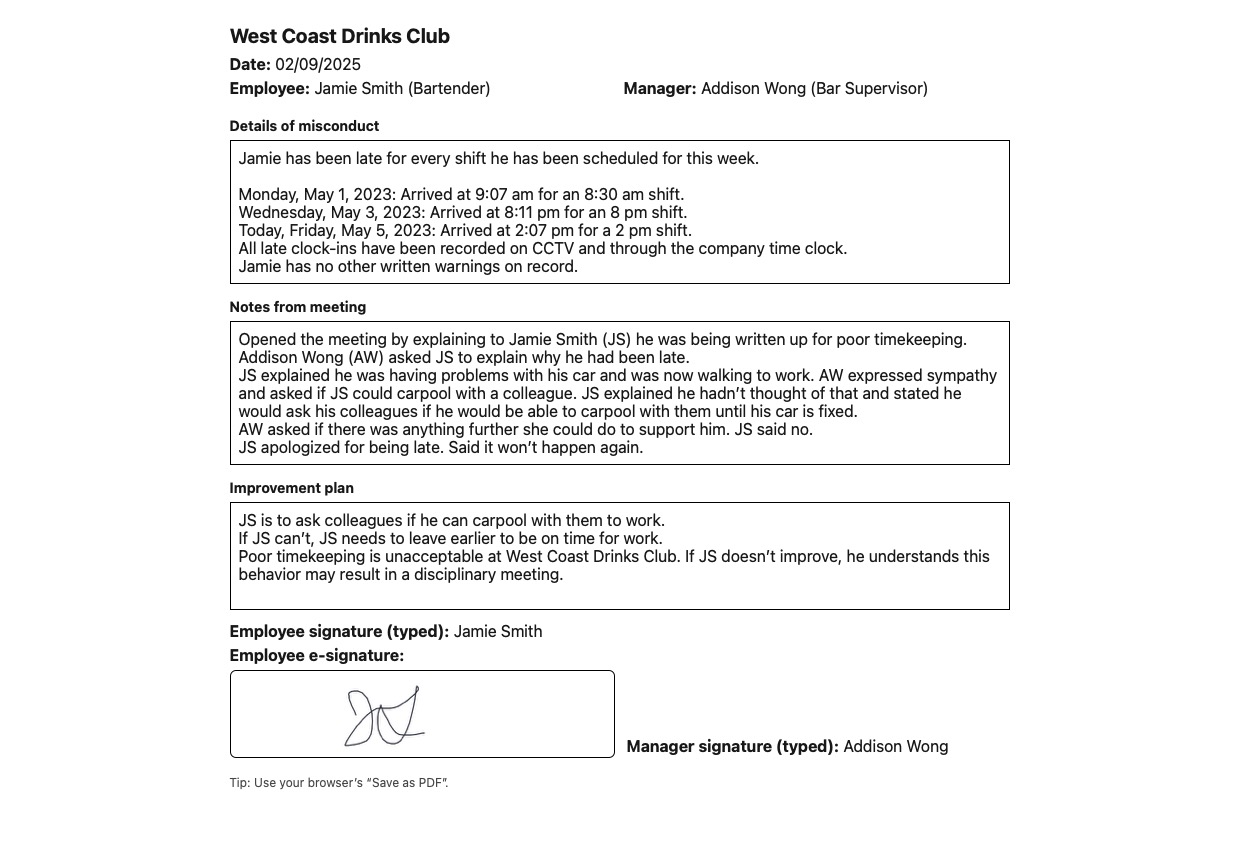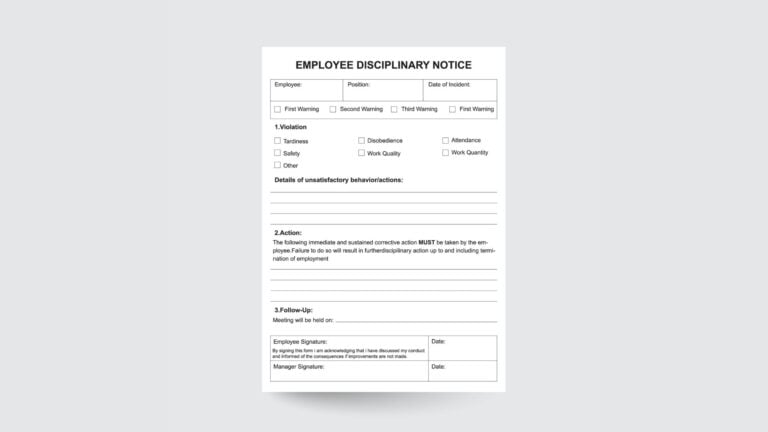It can be challenging to address an employee’s performance or behavioral issues when they arise. However, it’s an important part of maintaining a happy and productive workforce. Learn how to write up an employee, what to say during a write-up meeting, and some top tips for getting the best outcome possible.
As a manager, your responsible for ensuring your team members are meeting the expectations set for them. But sometimes, you’ll need to take disciplinary action when an employee isn’t behaving appropriately in the workplace.
One way to do this is to write up the employee.
Employee write-ups provide formal records of the worker’s unacceptable behavior. It’s essential to use consistent documentation when you write up an employee. This helps maintain a fair structure across your business and creates a written record of employee behavior over time.
When done correctly, writing up an employee can help improve their behavior and ensure that they’re meeting expectations and standards.
In this article, we explain how to write up an employee and what you should say during a write-up meeting. We also provide a free template for an employee write-up form.
Key Takeaways
- An employee write-up is a formal, written record of an employee’s unacceptable behavior.
- Write-ups are a method of employee discipline used to correct minor behavioral issues in the workplace.
- Fill out the write-up form as soon as you notice unacceptable behavior. Have the employee sign the document and keep a copy in their employee file.
What Is an Employee Write-Up?
An employee write-up is a formal, written record of a worker’s unacceptable conduct, behavior, or performance. It informs an employee that their behavior isn’t meeting expectations and provides them with feedback on what they need to change or improve. It also details the consequences of not improving.
Employee write-ups are used for minor issues that don’t warrant a disciplinary meeting but are still unacceptable. For example, frequent lateness, disruptive behavior such as rudeness, or minor dress code breaches.
An employee write-up typically serves as the first stage of your disciplinary process. However, you can also use it as a standalone method of employee discipline.
The difference between a write-up and a disciplinary meeting
Write-ups and disciplinary meetings are two methods of employee discipline. Managers and supervisors use them to address employee behavior that fails to meet expectations. While the two methods are similar, they serve different purposes.
A write-up acts like part of a “paper trail” to document an employee’s unacceptable behavior. It’s often the first step in a formal disciplinary process.
A disciplinary meeting is a formal meeting that takes place between an employee and their manager or supervisor. It usually happens when the employee’s behavior is severely inappropriate. For instance, discrimination, harassment, theft, safety violations, or serious insubordination.
Disciplinary meetings can also be used when a worker’s conduct hasn’t improved after receiving an employee write-up. For example, suppose you write up an employee for a dress code violation but they continue not to wear their uniform correctly. In that case, you may move forward with a disciplinary meeting.
Disciplinary meetings and write-ups provide an opportunity for you to draw a line about a certain type of behavior, correct it, and move forward together. The tone you take should be serious but supportive.
When Should You Write Up An Employee?
Usually, an employee is written up for minor disciplinary matters. Here are some examples of the types of behavior that might warrant a write-up:
- Persistent lateness.
- Disruptive or unprofessional behavior that doesn’t amount to insubordination. For example, swearing during a meeting or being rude to coworkers.
- Attendance or productivity issues. For example, using social media during work hours or engaging in other distractions that detract from productivity.
- Failure to follow proper policies or procedures. For instance, not properly completing required paperwork.
- Minor dress code breaches.
- Not implementing feedback on small issues.
You can deal with performance issues or frequent absences using write-ups, but they typically aren’t the best tool to address these problems. Instead, performance issues can be handled through your company’s capability policy. Frequent absences can be managed through your absence policy.
Similarly, some matters may be too serious to warrant an employee write-up. These can include:
- Theft.
- Physical violence toward a colleague, manager, or customer.
- Sexual harassment.
- Bullying.
- Serious breaches of health and safety.
- Serious insubordination.
Your disciplinary policy should clearly state what types of behavior will be considered a disciplinary matter and which may result in a write-up.
What To Include In an Employee Write-Up
While there are no legal requirements for what you should include in an employee write-up, a form can help you create structure in your business.
Here are some examples of what to include in your form:
- The company’s name and logo.
- The date of the write-up.
- The employee’s name and job title.
- The manager’s name and job title.
- A space to document details of the misconduct. This includes describing what happened, relevant dates, times, and witnesses.
- A space for notes of the discussion you’ve had with the employee. These should be brief notes that summarize the conversation. Don’t feel pressured to capture the conversation verbatim.
- A space to write down a plan for improvement. This should include what corrective action the employee needs to take to improve and what the consequences might be if they don’t improve their behavior.
- A space for both the manager and employee to sign the document.
You should complete an employee write-up shortly after you’ve noticed the unacceptable behavior.
What to do after filling in the employee write-up form
Schedule an informal meeting with your employee to present them with the form and explain your concerns. At this point, you can collect brief notes of the discussion, agree on actions moving forward, and then ask your employee to sign the form.
An employee might refuse to sign the write-up if they feel it’s unfair or inaccurate. Remind them they’re signing to acknowledge that they’ve received the write-up, not to agree with what it states about their behavior.
If they still refuse to sign the form, note their refusal in their signature box. A simple “employee refused to sign” will cover this. An employee refusing to sign the write-up doesn’t invalidate the document or prevent it from being used in future disciplinary proceedings.
You should then create a copy of the signed or unsigned write-up. Give one copy to your employee and store the other in their personnel file. If the employee refuses to take their copy, retain both copies yourself. Attach a note explaining that the employee didn’t take a copy with them.
You can also upload a digital copy of the write-up to your HR management software solution if you use one. This will ensure you always have a copy of the form if the original is lost or damaged.
Employee Write-Up Legal Implications You Should Know
There’s no federal law that says you have to write up employees, but if you want to protect your business, it’s probably a good idea. Even in at-will states, where you can terminate employees for almost any reason, your write-ups are the first thing lawyers point to in a lawsuit for discrimination, retaliation, or wrongful termination.
There are federal laws, like Title VII, the ADA, and FMLA, that protect employee rights. What that means is that how you write someone up matters. Always assume anything you put in writing could be used in a court of law. So, when you’re writing someone up, be consistent and objective, and focus on the employee’s specific actions, not what you think of them.
Where you’re located also matters. Some states require advance notice for specific actions or offer more protection to certain employee conduct. If your business operates in more than one state, check each state’s labor laws or speak to an employment attorney to be safe.
The best way to stay compliant is by having a process that’s fair and easy to replicate. That way, no one can claim the process was biased. Documentation must match your company’s policy and be applied across the board, so you don’t risk a discrimination claim. The goal is to create a clear, fair process that protects both your team and your business.
What Should You Do When Writing Up An Employee?
What you should say during a write-up will depend on the nature of the employee’s behavior. However, no matter the contents of the write-up, there are common best practices to follow.
Be clear and thorough
It can be difficult to write up an employee, but it’s essential to be clear and thorough.
In the write-up, clearly explain that the behavior you’ve noticed isn’t acceptable and that they’re receiving a write-up because of it. Detail exactly what behavior you’re talking about, when it happened, and why it isn’t acceptable. It may be that the behavior impacts other employees or that it’s against your code of conduct. It could also be for any other substantial reason.
If your employee raises questions during the write-up meeting, note them on the form and address them at the end. Don’t make up an answer if you’re unsure about how to respond to the question. Tell the employee you’ll check and get back to them. Don’t be afraid to ask another manager for support if you aren’t sure.
Use “I” statements
An “I” statement is a communication tool that focuses on the beliefs or feelings of the speaker. As the name suggests, these statements start with “I” rather than “you.”
Using an “I” statement is a slight language change that can make employees more receptive to what you’re telling them. This prevents blame-shifting and helps keep the conversation objective. Using “I” statements also helps build trust between you and your employee.
For example:
- “I have noticed you’ve been late three this week.” Instead of, “You’ve been late a lot this week.”
- “I am concerned that your behavior during team meetings has been disruptive.” As opposed to, “You are very rude in meetings.”
- “I am disappointed my feedback to you wasn’t actioned last week.” Instead of, “You didn’t listen to me last week.’
Be understanding
A write-up isn’t about punishing your employee. It’s about documenting and addressing poor behavior fairly and consistently. It’s a way to help employees know that their conduct isn’t meeting expectations and share guidance on how they can succeed going forward.
The tone of the meeting should be serious but also supportive and understanding. It’s important to give your employees the benefit of the doubt and support them through changing their behavior.
Here are ways to be understanding when writing up an employee:
- Use non-judgmental language. For instance, don’t write, “You were entirely unprofessional in your behavior at our last team meeting.” Instead, write, “I noticed during our last team meeting that you spoke over your colleagues and interrupted their contributions. This behavior was disruptive.”
- Provide context in your explanation. For example, if the employee has been frequently late, explain on the form why it’s important to be on time for work. You might note that tardiness impacts productivity, team morale, or the business’s reputation with customers.
- Offer resources and support. For instance, if an employee is struggling to meet productivity expectations, offer them additional support such as more training or a refresh on the employee handbook.
Be prepared for conflict
While an employee write-up is an opportunity to improve an employee’s behavior and performance, no one likes being told they aren’t doing a good job.
Conflict is a natural part of employee write-ups. The employee may feel emotional, like they’re being punished, or even that the decision is unjust. Actively listen and respond to your employee’s feelings.
During the write-up process, the employee might:
- Deny any wrongdoing. An employee may deny what you’re telling them, claim the information is untrue, or try to shut down the conversation. This is why coming to the meeting prepared with evidence is important. They can’t reasonably deny the write-up’s contents when there’s evidence in front of them.
- Disrupt the meeting. The employee may shout, swear, cry, or leave the room. If this happens, stay calm and objective. Get them a glass of water, or leave the room and wait until the employee has calmed down.
- Deflect the blame onto a coworker. Your employee may try to claim that their colleague is really at fault for their poor behavior. For instance, say an employee has been consistently missing deadlines. They may claim that their coworker distracts them and makes it difficult to get work done. Encourage the employee to focus on their own actions. For instance, you can say, “Let’s focus on developing strategies that will help you stay on track and meet your goals.”
- Place blame on you or the company. The employee may try to steer the conversation to attack you or the company as the reason for their unacceptable conduct. Avoid becoming defensive or engaging in an argument. Remain calm and redirect the conversation back to the specific behavioral issue at hand.
Free Employee Write-Up Template
This employee write-up form is ready to be used by your organization. Just enter all the relevant information, sign it, and save it as a PDF for easy reference.
Employee Write-Up Form
Fill the fields below, then click Download PDF.
Example Write-Up
If you aren’t sure how the template should be filled out, look at our sample write-up below:

Top Tips For Employee Write-Ups
Remain calm and objective
Feeling disappointed, upset, or even angry at your employee is understandable when you need to write them up. However, you should never write them up or hold the meeting while you’re angry or upset. These feelings make it difficult to be fair and objective.
Take some time to calm down. Go for a walk, or drink some water. Or, you can practice rephrasing emotional statements—like “You’re always late!”—into “I” statements. This will help you diffuse your feelings and prepare you to start the write-up process with a clear head.
Once you feel calm, fill in the write-up form at your own pace. If difficult emotions bubble up again, take a 10-minute break. Then, continue writing. Remember that it’s okay to complete the write-up form the day after an incident.
Document the issues in detail and keep a record
Include as much detail as possible in the write-up. This includes any dates, times, or further evidence that supports the write-up. Being prepared will make you feel confident holding the meeting and help you get the best outcome possible for yourself and your employee.
Once you’ve filled in the write-up form and held the meeting with your employee, keep the original copy of the write-up for future reference. This document might come in handy if the employee raises a legal dispute.
It’s also important to keep a record of the write-up to:
- Create a paper trail for further disciplinary action
- Support any future decisions regarding promotions or lateral changes
- Maintain a formal record of job performance.
Refer to company policy
Your company policy should support your decision to write up an employee.
If you write up an employee for reasons outside of your policy, employees might claim unfair treatment or raise a claim against you.
The policy should outline what behavior is acceptable, what may warrant a write-up, and what may constitute misconduct or gross misconduct. You can do this in either a list or table form.
Here are some examples of the different ways you could format this:
List form
Write-up
- Persistent lateness
- Breaches to dress code
- Disrespectful behavior
- Continued…
Misconduct
- Insubordination
- Being absent without permission (AWOL)
- Falsifying documents
- Continued…
Gross misconduct
- Theft
- Serious breaches of health and safety
- Harassment
- Continued…
Table form
| Write-up | Misconduct | Gross misconduct |
| Persistent lateness | Insubordination | Theft |
| Breaches to dress code | Being absent without lead | Serious breaches of health and safety |
| Disrespectful behavior | Falsifying documents | Harassment |
| Continued… | Continued… | Continued… |
In addition, your company policy should include a clause covering all bases in case employees exhibit unacceptable behavior not covered by the policy.
For example, a clause stating: “The following behaviors and actions are examples of matters that will normally be regarded as misconduct and will be dealt with under our Disciplinary Procedure. This list is intended as a guide and is not exhaustive.”
Talk to your human resources team about including this clause in your disciplinary policy.
Follow up with your employee
Once you’ve completed the write-up form, had a conversation with your employee, and filed the documents for safekeeping, it’s important to follow up with your employee.
This could be a casual check-in to see how they’re doing since they were written up or to check whether they’ve achieved the goals in the write-up form.
A follow-up meeting isn’t an opportunity to remind the employee of their wrongdoing. Instead, it’s a chance to ask whether they need further support or guidance in improving their behavior.
One check-up should be enough. However, if any further points are raised in the meeting, you may need to schedule additional meetings to support your employee.
The Bottom Line on Employee Write-Ups
Employee write-ups are an effective tool to manage employee behavior, give corrective feedback, and communicate expectations. They aren’t an opportunity to punish employees but instead are a chance for workers to understand how they can improve their behavior.
Write-ups are usually used for minor misconduct such as disrespectful behavior, persistent lateness, or a minor dress code violation. They can form part of your disciplinary process as a verbal warning or serve as a standalone tool.
Write-ups should be anchored by the behaviors set out in your disciplinary policy. Write-up forms should be filled in with as much detail as possible, presented to the employee during an informal meeting, signed, and stored safely for future reference.
FAQs
How do write-ups compare to other performance management tools?
Write-ups document misconduct or poor performance, providing a formal record if legal action is taken following a termination. Unlike coaching or feedback, they are corrective and often a last step before disciplinary action.
What are the next steps if behavior doesn’t improve after a write-up?
If behavior doesn’t improve, next steps may include suspension, demotion, or termination, depending on company policy and labor laws.
What are the consequences for employees who continue poor behavior?
Consequences include further disciplinary action, loss of advancement opportunities, or dismissal if issues continue after multiple write-ups.
How can I use write-ups to improve overall team performance and productivity?
Use write-ups to set clear expectations, identify patterns, and create accountability. Pair with coaching and training to turn corrective action into growth opportunities.
What is the best way to track and monitor employee performance after a write-up?
Track performance with software like Connecteam, which logs progress, tracks attendance, and stores documents for fair evaluation.
How can I track performance to prevent the need for write-ups?
Prevent write-ups by monitoring KPIs, providing regular feedback, and using employee management tools like Connecteam to identify and resolve issues early.



